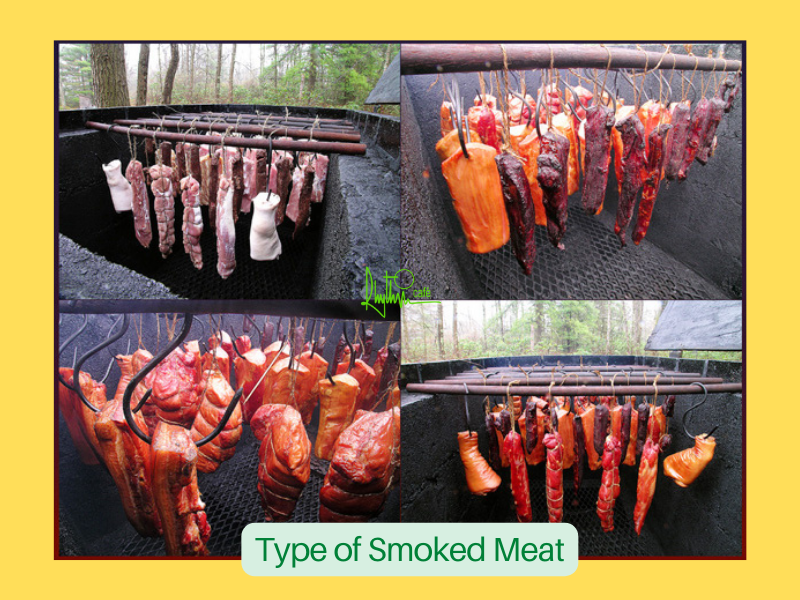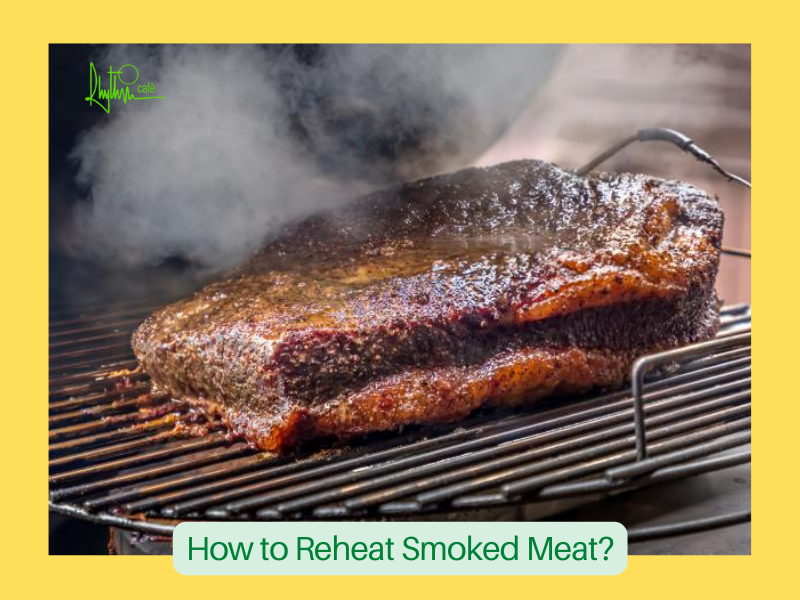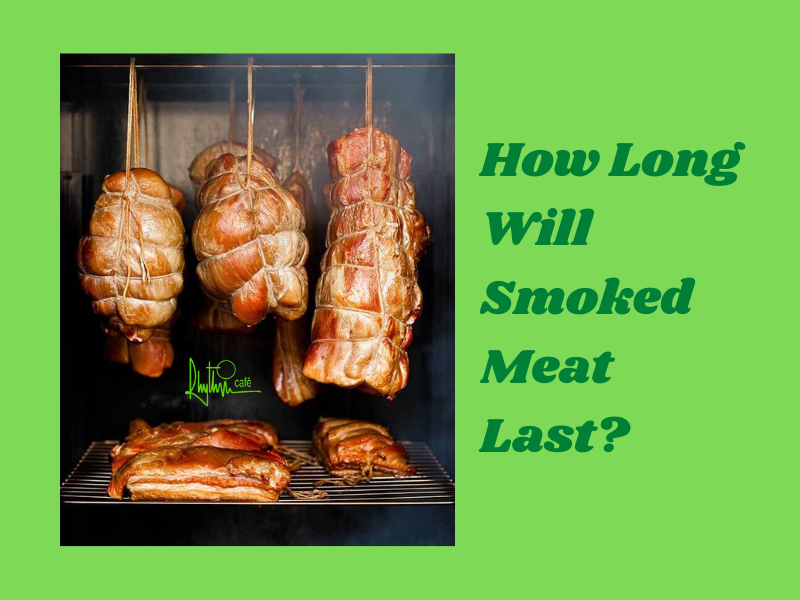Are you considering adding smoked meat to your meal rotation? If so, understanding how long will smoked meat last is crucial; from ensuring safety to preventing waste, knowing how to store and enjoy your smoked meat can save time and money. In this blog post, we’ll cover everything related to the storage life of smoked meats – from preparation through consumption – so that you can have delicious, safe meals on demand. Read on for more comprehensive information about longer-lasting meals with smoked meats!
What is Smoked Meat?
Smoked meat [1] is the product of a cooking process that employs smoke from burning wood as the primary flavoring agent. Among the various types of wood used for smoking, hickory, mesquite, and oak are the most popular choices. Each type of wood infuses the meat with its own unique flavor profile. For instance, hickory [2] yields a robust, smoky flavor, while mesquite imparts a milder, yet distinctive, woody sweetness.

Does smoking preserve meat?
As a professional chef, I must say that smoking meat is a wonderful way to preserve it, especially for hunters who want to keep their catch fresh for longer periods of time. Smoking involves using smoke from a wood fire to create an environment that inhibits the growth of spoilage organisms, similar to canning and brining. Not only does smoking preserve the meat, but it also gives it a delightful smoky flavor profile that is definitely worth acquiring.
Moreover, smoking meat can enhance its flavor and tenderness more than simply drying or salting it would. The preservative properties of smoke are well-known; smoking meats at low temperatures with a variety of woods such as oak, hickory, or pecan, slows down bacterial growth and adds unique flavors to the meat.
There are two methods of smoking meat: cold smoking and hot smoking. Cold smoking involves using cool temperatures and smoking for an extended period of time, ranging from 12 to 72 hours. This method results in a light smoky flavor profile, similar to smoked salmon. In contrast, hot smoking requires heating at least one side of the smoker to cook the food with indirect heat, like ribs. This process usually takes about six hours but produces more intense flavors due to the longer cooking cycle. For the best results, it is recommended to get the smoker to about 220 degrees and keep the smoking going for at least five hours. If you prefer a lighter flavor, opt for cold smoking (12+ hrs), but if you want that sweet smoky taste, then go for hot smoking (six hours).
So how long can smoked meat last?
The consensus is that smoked meats have a long shelf life if properly packaged and stored. If stored at the correct temperature and humidity, it will expire 1-2 weeks past their “best or used by” date.
It’s important to understand the different smoking techniques and their effects on the shelf life of smoked meat. While hot smoking is the most common method, cold smoking, warm smoking, and smoke roasting can also be used.
Cold smoking involves smoking meat at temperatures below 100°F for an extended period of time, often 12 hours or more. This results in a subtle smoky flavor and a softer texture, similar to cured meat. Cold-smoked meat must be refrigerated and consumed within 5 days, as bacteria can still grow at these lower temperatures.
Warm smoking, on the other hand, involves smoking meat at temperatures between 100°F and 140°F. This method is often used for fish and poultry and produces a slightly more pronounced smoky flavor than cold smoking. Warm-smoked meat can be stored in the refrigerator for up to a week.
Smoke-roasting combines the techniques of smoking and roasting by cooking the meat at higher temperatures (above 250°F) with the addition of smoke. This method is used for larger cuts of meat, such as brisket and pork shoulder, and produces a deeper smoky flavor and a tender texture. Smoke-roasted meat can be stored in the refrigerator for up to 5 days.
Regardless of the smoking technique used, it’s important to properly store smoked meat to prevent bacterial growth. Smoked meat should be refrigerated within two hours of being removed from the smoker and consumed within the recommended time frames. If you plan to store smoked meat for a longer period of time, wrapping and freezing it can extend its shelf life up to three months.
How long does smoked cured meat last?
I can tell you that smoked cured meats like bacon and ham are a delicious addition to any meal. However, they do have a limited shelf life. If you store them in the refrigerator, they will last for 2-4 days. If you freeze them, they will last for up to 6 months.
But what if you want to store your smoked meats for even longer than that? The best solution is to vacuum seal them.

By vacuum sealing, you remove all the air from the package, which prevents the meat from drying out and reduces the risk of freezer burn. When properly vacuum sealed, smoked meats can last for up to a year in the freezer. This is a great option if you like to buy in bulk or want to prepare meals in advance. Just make sure to label your packages with the date so you know how long they have been stored.
How long does smoked Brisket last?
When properly stored, smoked brisket can last for up to 4 days in the refrigerator or be stored indefinitely in the freezer. To ensure the brisket stays fresh, it is important to properly store it.
First, place a layer of plastic wrap directly on top of any liquid surfaces that may have formed, and then tightly seal it with an additional piece of cling film or use another airtight container like Tupperware to cover the dish.
When storing the brisket in the refrigerator, it should be placed on the bottom shelf to prevent any juices from leaking onto other foods. It is also recommended not to stack dishes more than two high to avoid the juices from one dish leaking into another.
Finally, it is important to note that smoked beef should be consumed within four days after being made. If you plan on saving some for later, be sure not to buy too much at once to avoid any waste.
>> See more: How long to smoke a Brisket at 225
How long will smoked meat last without refrigeration?
The answer to this question depends on several factors, including the type of meat, the smoking method, and the storage conditions.
In general, smoked meat can last for several days to several weeks without refrigeration if it is properly prepared and stored. However, it is not recommended to store smoked meat for extended periods without refrigeration, as this can increase the risk of bacterial growth and foodborne illness.
Some types of smoked meat, such as beef jerky or smoked fish, are specifically prepared for long-term storage without refrigeration. These products are typically cured and dried to remove moisture and prevent bacterial growth. Properly prepared beef jerky, for example, can last for several months without refrigeration if stored in an airtight container.
Other types of smoked meat, such as smoked ham or bacon, are typically not intended for long-term storage without refrigeration. These products should be stored in the refrigerator or freezer to prevent bacterial growth and maintain their quality.
In general, it is important to follow safe food handling practices when storing and consuming smoked meat. This includes keeping the meat at a safe temperature, washing your hands and utensils before handling the meat, and discarding any meat that appears spoiled or has an unusual odor or appearance.
What are the different methods of smoking meat?
The notion that smoking meat involves simply cooking it over an open fire or wood chips is not entirely accurate. In reality, various smoking techniques produce different outcomes, and they necessitate different temperatures that impact the meat’s storage times.
– Hot Smoking
Hot smoking is the most popular method of food smoking, and it gets its name from the internal temperature of the smoker, which typically ranges between 225°F and 250°F. Even at these temperatures, it can take several hours to hot smoke meat, and for a large brisket, it may even require an entire day. While hot smoking can cook the meat, it is not necessary to brine it beforehand, although some pitmasters may do so to enhance the flavor.
The primary goal of hot smoking is to infuse the food with flavor while it cooks rather than to extend its shelf life. This is why, despite being smoked, hot smoked food can only be stored in the refrigerator for up to four days.
– Warm Smoking
When it comes to smoking meat, warm smoking is a technique that involves using temperatures between 77°F and 104°F. This method is ideal for preserving the texture of delicate meats such as fish, which are typically smoked for short periods of time.
Pre-cooked meats like bacon and sausage are also often warm-smoked to add a smoky flavor. However, it’s important to note that warm smoking pork or poultry can be dangerous as it requires leaving the meat in the Danger Zone (between 40°F to 140°F) for extended periods of time, which increases the risk of food poisoning.
– Cold Smoking
Cold smoking is a preservation method that keeps food raw throughout the process, in contrast to hot-smoking. This technique was commonly used by our ancestors before refrigeration. To prepare the meat for cold smoking, it is first cured by dehydrating it with salt, creating an environment that hinders bacterial growth.
To smoke the cured meat, it is hung in an area with good airflow for 1 to 12 hours to develop a pellicle, which is a dry and slightly sticky layer that helps the smoky flavors stick to the meat. After the pellicle has formed, the meat is then smoked at a temperature that is kept below 90°F. Many cold smokers use an offset design to produce the smoke in a separate firebox and then move it into the smoking chamber, to avoid exposing the meat to the heat of the fire.
The process of cold-smoking meat can take multiple days, and the duration may vary depending on the type of meat and the size of the cut. As a professional chef, I recommend following all safety precautions and guidelines when cold-smoking meat to avoid any foodborne illnesses.
– Smoke Roasting
Smoke roasting is a cooking method that combines traditional roasting techniques and recipes with the addition of wood smoke to enhance the flavor. You can easily achieve this method in a conventional fan oven with the help of a smoking accessory that holds smoldering wood chips or pellets, such as the A-MAZE-N Pellet Smoker.
However, it’s important to note that smoke roasting doesn’t have any significant preserving effect on the meat being roasted; its main purpose is to add another layer of flavor.
How to Tell if Smoked Meat is Bad?
It is important to be able to recognize if smoked meat has gone bad, as consuming spoiled meat can lead to foodborne illness. Here are some signs to look out for:
- Appearance: If the meat appears slimy or has a grayish or greenish tint, it may be spoiled.
- Texture: Spoiled meat may feel mushy or slimy to the touch.
- Smell: If the meat smells sour, ammonia-like, or foul, it may be spoiled.
- Taste: If the meat tastes off, has an unusual texture, or causes an upset stomach, it may be spoiled.
It is important to note that smoked meat may have a slightly different appearance, texture, and smell compared to non-smoked meat, so it’s important to trust your senses and use good judgment when determining if it is safe to eat. Additionally, it’s always a good idea to follow safe food handling and storage practices to reduce the risk of foodborne illness.
How to Thaw Smoked Meat?
Thawing smoked meat is a delicate process as it needs to be done properly to ensure the meat remains safe to eat and doesn’t lose its flavor or texture. Here are some steps to follow when thawing smoked meat:
1) Remove the smoked meat from the freezer and transfer it to the refrigerator. Make sure to place the meat in a leak-proof container or on a plate to prevent any juices from dripping onto other food items in the fridge.
2) Leave the smoked meat in the refrigerator to thaw slowly. This process can take anywhere from several hours to a day or more, depending on the size and thickness of the meat. It’s important to note that larger cuts of meat will take longer to thaw than smaller ones.
3) If you’re in a hurry, you can thaw smoked meat in cold water. Fill a large bowl or sink with cold water and place the meat in a leak-proof plastic bag. Make sure to change the water every 30 minutes to ensure it remains cold. This process should take about 30 minutes per pound of meat.
4) Never thaw smoked meat at room temperature or in warm water, as this can increase the risk of bacterial growth and cause the meat to spoil.
5) Once the smoked meat is fully thawed, it can be reheated and served. Reheat the meat in a preheated oven, on the stovetop, or on the grill until it reaches an internal temperature of at least 165°F to ensure that it is safe to eat.
6) In the refrigerator
The refrigerator is the safest and most effective method for thawing smoked meat. Simply place the vacuum-sealed package or the airtight container of smoked meat in the refrigerator and let it thaw slowly over a period of several hours to a few days, depending on the size of the cut.
It is important to note that this method takes longer, but it is the most recommended method as it allows the smoked meat to thaw at a safe temperature and without any risk of bacterial growth. It is also the best method to retain the texture and quality of smoked meat.
7) In cold water
If you are short on time, you can use the cold water method to thaw smoked meat. Simply place the vacuum-sealed package or the airtight container of smoked meat in a bowl of cold water. Change the water every 30 minutes to keep the water temperature cold and to hasten the thawing process.
It is important to use cold water, as warm or hot water can cause the meat to partially cook and create an environment for bacterial growth. This method is faster than the refrigerator method but requires more attention and effort.
8) In the microwave
The microwave is the quickest way to thaw smoked meat, but it is not the most recommended method. Smoked meat that is thawed in the microwave may end up being partially cooked, which can affect the texture and quality of the meat.
If you choose to use the microwave method, make sure to follow the manufacturer’s instructions for defrosting meat. It is recommended to use a lower power setting and to stop and stir the meat every 30 seconds to ensure even thawing. Also, use the meat immediately after thawing as it may start to cook in some parts and create an environment for bacterial growth.
Overall, it is important to thaw smoked meat properly to retain its texture, quality, and safety. Choose the method that suits your needs and the amount of time you have available, but make sure to follow the recommended guidelines for each method to avoid any risks of bacterial growth or partial cooking.
>> See more:
- How long is Rotisserie Chicken good for in the fridge
- How long can Cooked Bacon sit out
- How long is Cooked Salmon good for
- How long does Cake last in the fridge
How to Reheat Smoked Meat?
Reheating smoked meat is a delicate process that requires careful attention to prevent the meat from becoming dry or overcooked. Here are some tips on how to reheat smoked meat:

- Use a low heat setting: Whether you are using an oven or a grill, it is important to use a low heat setting to reheat smoked meat. This will help to prevent the meat from drying out or becoming overcooked.
- Add moisture: To prevent the meat from becoming dry, you can add some moisture to the reheating process. You can do this by adding a little bit of broth or water to the pan when reheating in the oven or by using a basting sauce when reheating on the grill.
- Wrap in foil: Wrapping the meat in foil can help to lock in moisture and prevent the meat from becoming dry. Simply wrap the meat in foil and place it in the oven or on the grill to reheat.
- Monitor the temperature: It is important to monitor the internal temperature of the meat as it reheats. You can use a meat thermometer to ensure that the meat reaches a safe temperature of 165°F before serving.
- Let it rest: Just like when cooking fresh meat, it is important to let the reheated smoked meat rest for a few minutes before slicing or serving. This will allow the juices to redistribute throughout the meat and help to keep it moist.
By following these tips, you can reheat smoked meat without compromising its flavor or texture.
How to Store Smoked Meat?
Proper storage is crucial in maintaining the quality and safety of smoked meat. Here are some guidelines for storing smoked meat:
- Refrigerate or freeze promptly: After smoking the meat, cool it down to room temperature before refrigerating or freezing it. It is important to refrigerate or freeze smoked meat within two hours of smoking to prevent bacterial growth.
- Store in airtight containers: Place the smoked meat in airtight containers or wrap it tightly in plastic wrap or aluminum foil. This will help prevent air from getting in, which can cause the meat to dry out or develop freezer burn.
- Label and date the containers: Label the containers with the type of meat, the date it was smoked, and the use-by date. This will help you keep track of the freshness and avoid consuming expired meat.
- Refrigerate or freeze at the proper temperature: Smoked meat should be refrigerated at a temperature of 40°F or below and should be consumed within 3 to 4 days. To freeze smoked meat, make sure the temperature of the freezer is set at 0°F or below. Smoked meat can be safely stored in the freezer for up to 6 months.
- Thaw properly: When you’re ready to eat the smoked meat, thaw it in the refrigerator or in cold water. Do not thaw smoked meat at room temperature as it can lead to bacterial growth.
How long will hot-smoked meat last?
As previously mentioned, hot smoking is a technique used to infuse your food with a rich, tangy flavor while cooking it low and slow. While the smoke does cause the aldehydes to leach moisture from the meat, it does not serve as a substitute for proper curing and drying, which is crucial in cold smoking.
To ensure that your hot smoked meat stays fresh for the longest time possible, you need to focus on controlling bacterial growth. The first step is to adhere to food safety guidelines, which includes not cross-contaminating your meat with dirty utensils or chopping boards, ensuring that the meat reaches the minimum safe temperature recommended by the Food Safety and Inspection Service, and refrigerating the meat within two hours of being removed from the smoker.
To maximize the shelf life of your smoked meat, you should store it in the smallest container possible or wrap it thoroughly in foil. To reduce the amount of oxygen that comes into contact with the meat, you can use a vacuum sealer. If you follow these steps, you can safely store your smoked meat in the refrigerator for up to 4 days or in the freezer for up to 3 months.
How long will cold-smoked meat last?
Cold-smoked meat can last longer than hot-smoked meat due to the curing, airing, and smoking process, which creates an environment hostile to bacterial growth.
When properly cured and smoked, cold-smoked meat can be edible for months, but the downside is that it can be dangerous if not done correctly. If the meat is not cured properly, it can lead to the growth of bacteria such as Clostridium botulinum and Listeria monocytogenes, both of which can cause severe illness.
Cold smoking does not raise the temperature of the meat high enough to eliminate potentially deadly bacteria. Cold-smoked fish can also contain parasites like tapeworms, which are usually destroyed by cooking.
Individuals who are particularly old, very young, pregnant, chronically ill, or immunocompromised should avoid cold-smoked meats, particularly home-cured ones, as they are particularly vulnerable to these bacteria and parasites.
However, foods like tofu, cheese, eggs, nuts, and pre-cooked meats like bacon can be safely cold-smoked without the risk of botulism.
Common mistakes when preserving Smoked Meat
There are several mistakes that people can make when preserving smoked meat, which can lead to spoilage and even illness. Some common mistakes include:
- Not properly curing the meat before smoking it: Curing the meat with salt and other ingredients before smoking helps to kill bacteria and prevent spoilage. Skipping this step can lead to spoilage and bacterial growth.
- Failing to monitor the temperature during smoking: Smoking the meat at too low a temperature can result in bacterial growth, while smoking at too high a temperature can cause the meat to dry out or become overcooked.
- Using too much smoke or smoke that is too intense: Too much smoke or smoke that is too strong can make the meat taste bitter or acrid, and can also cause it to spoil more quickly.
- Not storing the meat properly: Smoked meat should be stored in a cool, dry place, preferably in airtight containers or vacuum-sealed bags to prevent spoilage.
- Keeping the meat for too long: Even properly cured and smoked meat has a limited shelf life. Eating smoked meat that is past its expiration date can lead to illness.
- Not following proper sanitation procedures: Contamination from bacteria or other pathogens during the preservation process can lead to illness. It is important to clean and sanitize all equipment and work surfaces thoroughly before and after handling the meat.
- Using contaminated meat: If the meat is contaminated with bacteria or other pathogens before smoking, the smoking process will not eliminate them. Only use fresh, high-quality meat for smoking to ensure safety and quality.
- Not thawing frozen meat properly: If you are using frozen meat for smoking, it is important to thaw it properly to prevent bacteria from growing. Thaw the meat in the refrigerator or under cold running water, rather than leaving it out at room temperature.
- Not using a meat thermometer: It can be difficult to tell if smoked meat is fully cooked just by looking at it. Using a meat thermometer to check the internal temperature is the only way to ensure that the meat is safe to eat.
- Reusing brine or marinade: If you are using a brine or marinade to flavor the meat before smoking, be sure to discard it after use. Reusing it can lead to contamination and spoilage.
What to Serve with Smoked Meat?
Smoked meat is a delicious and flavorful dish that can be served on its own or with a variety of sides to complement its smoky taste. Here are some great options for what to serve with smoked meat:
-Baked beans: Sweet and savory baked beans are a classic pairing with smoked meat. The flavors complement each other perfectly, and the soft texture of the beans is a nice contrast to the chewy, smoky meat.
-Coleslaw: Creamy, tangy coleslaw is another classic side dish that pairs well with smoked meat. The refreshing crunch of the cabbage and carrots is a great contrast to the rich, smoky flavor of the meat.
-Cornbread: Sweet or savory cornbread is a delicious complement to smoked meat. The crumbly texture of the bread pairs well with the tender meat and helps to soak up any juices or sauces.
-Roasted vegetables: Roasted vegetables such as carrots, sweet potatoes, or Brussels sprouts make a healthy and flavorful side dish to accompany smoked meat. They are also easy to prepare and can be seasoned with a variety of herbs and spices.
-Macaroni and cheese: Creamy, cheesy mac and cheese is a comfort food that pairs well with smoky meat. The rich, creamy texture of the pasta is a great complement to the smoky flavor of the meat.
-Potato salad: Tangy, creamy potato salad is a great side dish for smoked meat. The mild flavor of the potatoes provides a nice contrast to the bold, smoky flavor of the meat.
-Grilled vegetables: Grilled vegetables such as zucchini, eggplant, or bell peppers are a tasty and healthy option to serve with smoked meat. The charred flavor of the vegetables complements the smoky taste of the meat.
These are just a few options for what to serve with smoked meat. Ultimately, the best side dishes will depend on your personal taste preferences and the type of smoked meat you are serving.
FAQs About How long will smoked meat last?
How long does smoked meat last in the fridge?
Smoked meat can last for about 4-5 days in the fridge if stored properly in an airtight container.
Can I freeze smoked meat?
Yes, you can freeze smoked meat for up to 6 months. Make sure to wrap it tightly in plastic wrap or aluminum foil, or store it in an airtight container or freezer bag.
How do I know if smoked meat has gone bad?
If the smoked meat has a sour, rancid or off odor, or if it appears slimy, discolored or has mold on it, it has likely gone bad and should be discarded.
Does smoking meat preserve it?
Smoking meat does help to preserve it by reducing its water content and creating an environment that is hostile to bacterial growth. However, smoking alone may not completely preserve the meat and additional measures like proper storage and handling may be necessary.
Does smoked meat stay fresh longer?
Yes, smoked meat can stay fresh longer than unsmoked meat due to the preservation effects of the smoking process. However, proper storage and handling are still important to ensure its freshness and safety.
Does smoked meat last longer than cooked meat?
Yes, smoked meat can last longer than cooked meat due to its reduced water content and the preservation effects of smoking. However, like with any meat, proper storage and handling are important to ensure its freshness and safety.
Conclusion
How long will smoked meat last? Smoked meat can last longer if stored properly, whether it’s hot-smoked or cold-smoked. Hot-smoking meat adds a great flavor and can be refrigerated for up to 4 days or frozen for up to 3 months. Cold-smoking food not only adds character but also preserves the meat for months. However, cold-smoking can pose a risk of bacterial infections, so it’s recommended to try cold-smoking something other than meat until you gain more experience. Share your amazing hot-smoked recipe or tips for minimizing the risks of cold-smoking in the comments below.

Leslie Fowler is the founder of Rhythm Cafe, a barbecue restaurant with over 15 years of experience. Leslie is an exceptional pitmaster and grill expert, specializing in smoking briskets and pork shoulders on charcoal, wood, or propane grills/smokers. Leslie has also tried out almost every model of kitchen appliance available on the market, making her an authority on grills and smokers.

